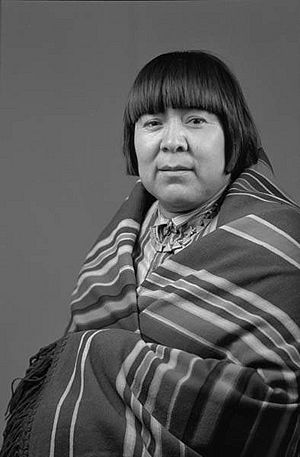Joe Herrera facts for kids
Quick facts for kids
Joe Hilario Herrera
|
|
|---|---|
| See-Ru | |
| Born | May 17, 1923 Cochiti, New Mexico, U.S.
|
| Died | September 26, 2001 (aged 78) Santa Fe, New Mexico, U.S.
|
| Burial place | Santa Fe National Cemetery |
| Nationality | Cochiti Pueblo, San Ildefonso Pueblo, United States |
| Other names | Blue Bird |
| Education | Santa Fe Indian School, University of New Mexico |
| Occupation | painter, teacher, politician, radio newscaster, Pueblo activist |
| Parent(s) |
|
| Awards | Ordre des Palmes Académiques (1954) |
Joe Hilario Herrera (born 1923–2001) was an important American Pueblo artist. He was also known by his Native name, See-Ru. Joe Herrera was a painter, teacher, radio newscaster, and a leader for Pueblo people. His family came from both the Cochiti and San Ildefonso communities. He was the son of the famous artist Tonita Peña and studied at the Santa Fe Indian School.
Contents
Growing Up and Learning
Joe Hilario Herrera was born on May 17, 1923, in Cochiti, New Mexico. His father was from Cochiti, and his mother, Tonita Peña, was from San Ildefonso. Joe learned a lot about art from both sides of his family.
He became interested in painting by watching his mother's husband, Julian Martinez, paint. But most of all, his mother, Tonita Peña, was his biggest influence. She was one of the most well-known Native American female painters of her time. Joe would help his mother by keeping flies away from her paints. In return, she gave him paint to try out when he was just five years old.
Like many other Pueblo artists from the Southwest, Herrera went to the Studio School at the Santa Fe Indian School. This school was first started by Dorothy Dunn. Later, it was led by the San Juan Pueblo artist Geronima Montoya. Early in his career, Joe's art looked like the flat watercolor style that was common at the school.
From 1941 to 1945, Joe Herrera served in the United States Army during World War II. He was stationed in the Caribbean. After the war, he used the G.I. Bill to earn a bachelor's degree in art education from the University of New Mexico.
Teaching Art
After college, Joe Herrera taught art classes in the Albuquerque Public Schools. He also taught at Indian Schools across New Mexico for the United States Department of Education. His teaching even influenced one of his students, the painter Helen Hardin.
His Art Work
At first, Joe Herrera's paintings showed Pueblo dancers. He used flat, opaque watercolors, similar to his mother's style and what he learned at the Studio School. Like many artists from the school, he also painted murals. Murals were a popular way for Native artists to get work in the 1930s and 1940s.
However, Joe Herrera was one of the first Native American artists from the Studio School to try something new. He started moving away from realistic art and into more abstract styles. An artist named Raymond Jonson helped him make this change. Joe studied with him at the University of New Mexico between 1950 and 1953. In the 1950s, Herrera's art became known around the world after an exhibition at the Museum of Modern Art (MoMA).
In 1954, the French government gave Herrera a special award called the Ordre des Palmes Académiques. This means "Order of Academic Palms" in English.
Joe Herrera once explained his art by saying he tried to mix new, modern art ideas with traditional Pueblo images. His art has been called "coolly decorative," which is different from his mother's "warmly natural" style. Joe's way of combining traditional Pueblo art, his school training, and modern abstract styles was very important. It influenced many artists who came after him.
Public Service and Later Paintings
From 1953 to 1967, Joe Herrera worked as the secretary for the All Indian Pueblo Council. He was also a member of the National Congress of American Indians. He even spoke to the United States Congress in Washington, D.C., to support laws that would help Native Americans find jobs and grow their economies. In 1968, Herrera was hired to lead a New Mexico State Employment Commission. His job was to help Native Americans find work.
For seven years, he also worked as a newscaster at the KTRC radio station in Santa Fe.
After he stopped his public service work in 1983, he went back to painting. But by the early 1990s, his eyesight became poor, and he had to stop painting.
Death and Legacy
Joe Herrera passed away on September 26, 2001, in Santa Fe, New Mexico, due to complications from diabetes. His funeral was held at the Cathedral Basilica of St. Francis of Assisi. He is buried in the Santa Fe National Cemetery.
You can find Joe Herrera's artwork in many public museums. Some of these include the Fred Jones Jr. Museum of Art at the University of Oklahoma, the Detroit Institute of Arts, the Gilcrease Museum, the Indianapolis Museum of Art, the National Museum of the American Indian, and the Museum of Northern Arizona.
In 2018, his art was shown alongside his mother's in an exhibition called "Generations in Modern Pueblo Painting: The Art of Tonita Peña and Joe Herrera." This show was at the Fred Jones Jr. Museum of Art at the University of Oklahoma. The exhibit highlighted how both artists greatly influenced future painters. It showed how both mother and son created new art styles that grew from tradition but also broke away from it.
Herrera's work was also part of "Stretching the Canvas: Eight Decades of Native Painting" (2019–2021). This was a large exhibition at the National Museum of the American Indian and George Gustav Heye Center.
See also


